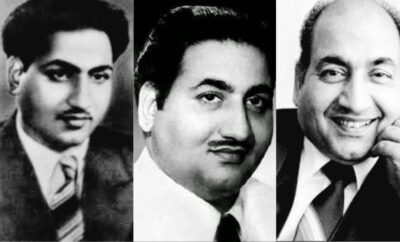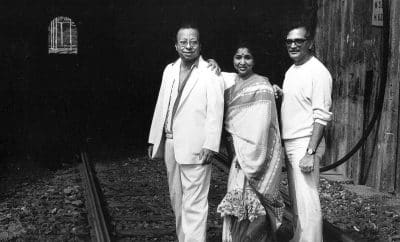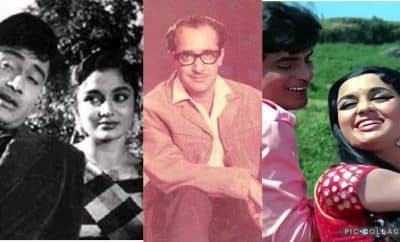Collections
Kavita Krishnamurti – Golden Voice of the Nineties
Veteran composer and playback singer of the golden era, Hemant Kumar, was invited to St. Xavier College in Mumbai as the chief guest of some programme. There, a teenager college student sang the Asha – O.P. Nayyar classic “Jaaiye aap kahaan jaayenge”, which thoroughly impressed Hemant Kumar, so much so that he offered the student an opportunity to sing with him in his stage shows. She then did a few stage shows with Hemant Kumar, and one fine day he called her to Rajkamal Studio for recording a Bengali film song. She had only a few lines to sing, which she rehearsed, and kept waiting for further instructions.
This college student named Sharada, albeit a South Indian, was born and brought up in Delhi. Like millions of Indians, she had grown up fondly listening to the golden era Hindi film songs on radio. Lata Mangeshkar was like the goddess of singing, like Maa Saraswati for her. She would intently listen to her songs on radio and hum them to herself. Right from her tender years, she was surrounded by music, and imbibed classical music from her mother who was a trained Carnatic vocalist, and Bangla music from her neighbours cum close family friends Bhattacharyas. She would also participate in various singing competitions as a child and had won her first award at the age of nine. Her aunt Protima Bhattacharya soon realised that this girl had an immense musical acumen and could make a perfect playback singer. She herself therefore took Sharada to Mumbai and admitted her to St. Xavier College, where she came across Hemant Kumar as aforesaid.
Coming back to the recording scene of the Bengali film song – Sharada, cluelessly waiting for further instructions, asked Hemant Kumar if they were waiting for someone. Just as Hemant Kumar was about to reply, the door opened, and none other than Sharada’s Maa Saraswati entered the recording studio. While Sharada’s heart started brimming with joy and excitement that her first ever film song was going to be a duet with Lata Mangeshkar, it also sank due to the same thought, making her lose her voice. She somehow gathered herself and stood beside Lata Mangeshkar for the final rehearsal. She was so engrossed in closely watching her goddess sing the song that she forgot to sing her own lines. After a stern question by the agitated Hemant Kumar and the “I-know-what-just-happened” smile through her mischievous eyes underneath her spectacles by Lata Mangeshkar, the song was finally recorded.
The song was “Shokhi bhaabona kaahaare bole, shokhi jaatona kaahaare bole” from Sriman Prithviraj (1973), which was based on Gurudev Ravindranath Tagore’s composition and lyrics.
In the stage shows with Hemant Kumar, the audience would often request Sharada to sing the song “Titli udi, ud jo chali” from Suraj (1966). Sharada would then have to clarify that the Sharada standing in front of them was Sharada Krishnamurti and not the playback singer Sharada (Iyengar) who had sung the song. Hemant Kumar therefore insisted that she changed her name and Sharada Krishnamurti was rechristened as Kavita Krishnamurti. Hemant Kumar later recommended Kavita Krishnamurti as a good singer to Manna Dey, and she started accompanying Manna Dey in his stage shows too.
Circa 1977, while Kavita Krishnamurti was still singing in stage shows, her relative and Hema Malini’s mother Jaya Chakravarti introduced her to the composer duo Laxmikant – Pyarelal. The Mangeshkar sisters were still at the zenith of their careers then and Kavita Krishnamurti perhaps had no ambition to become a playback singer amidst the formidable competition. However, Laxmikant – Pyarelal called her one day and asked her if she was available for recording a song. The song was composed for Lata Mangeshkar. However, she was not available for recording it, though the shooting was scheduled. Kavita Krishnamurti was thus to be a dubbing artiste and her version would be used only for shooting purposes, later to be replaced with Lata Mangeshkar’s version. Kavita Krishnamurti agreed to record the song, and it marked the beginning of her career as a dubbing artiste.
She has often stated that her stint as a dubbing artiste (mainly for Lata Mangeshkar) was a great learning experience, for every time she would compare her version with Lata Mangeshkar’s final version and like Ekalavya in Mahabharat, identify areas of improvement in her own singing and pick up newer aspects of playback. Like a bee gathering nectar from all over and converting it to honey, she kept on gathering all good things from the then celebrated singers and evolved as a versatile and preferred playback singer having sweet voice and a very strong classical base. The success she attained was clearly not easy and she had to go through a tough penance as a dubbing artiste before reaching the height. Perhaps due to this, alongside her innate modesty, she has always remained grounded in spite of being a top singer and respected figure in Hindi cinema for many years.
Even before she started singing as a dubbing artiste, she had recorded a song for the film Kadambari (1976), which was a recreation of the famous Lata classic “Aayega aane waala” from Mahal (1949). It was filmed on Shabana Azmi. However, not much of information is available on how she got the opportunity, nor does she speak much about this song. As this was a recreation of an old song, she perhaps does not consider it as her first independent break.
During her stint as a dubbing artiste, she got a chance to sing a song as independent playback singer – “Kaahe ko byahi bides re” from Maang Bharo Sajna (1980). As all other songs in the soundtrack composed by Laxmikant – Pyarelal are sung by Lata Mangeshkar and Asha Bhosle, Kavita Krishnamurti would have perhaps recorded this song too for either of the sisters, which probably would have been retained in the film in her own voice for some reason. Her rendition is quite emotive and heart rending. Nonetheless, it did not help her get noticed as a playback singer.
In the meantime, Kavita Krishnamurti had also recorded a song for the Kannada film Ondanondu Kaladalli (1978). In the early 1980s, she recorded the scratch version of a song for Bappi Lahiri, which was to be later recorded in Lata Mangeshkar’s voice. After a few months of recording, she came across a news item in a South Indian magazine that Lata Mangeshkar denied recording the song. Kavita Krishnamurti was scared to death. She thought, as Lata Mangeshkar denied finalising her scratch version, her career so much as a dubbing artiste was sure to end, before her career as a playback singer could even begin. However, a little later, she got to read the details of this ‘perceived mishap’ in a Hindi magazine. The Hindi magazine reported that when Lata Mangeshkar arrived at the recording studio for recording the final version, she expressed her wish to hear the scratch version. After hearing it, she said, “This girl has sung really well! Why do you want me to record it again?” Despite a lot of convincing by Bappi Lahiri and the producer, Lata Mangeshkar remained insistent and did not record the song. Kavita Krishnamurti heaved a sigh of relief! What seemed to be a threat to her career suddenly started feeling like a gold medal to her. However, unfortunately, the song was recorded again in Asha Bhosle’s voice at the producer’s dictate, and Kavita Krishnamurti’s version remained a scratch version. The song was “O mere saajna” from Naukar Biwi Ka (1983).
Recognition as a playback singer was thus still a distant dream. Though Kavita Krishnamurti recorded a few songs here and there for some small-time films in the early 1980s, many of which never saw the light of day, it was not until 1985 that she got noticed as a playback singer. The song in which she was so noticed for the first time was the child version of the song “Tumse milkar na jaane kyun” from Pyar Jhukta Nahin (1985).
Soon after she had recorded the scratch version of the song “Tumse milkar na jaane kyun” as a duet with Shabbir Kumar (where Lata Mangeshkar was to replace her), the composers Laxmikant – Pyarelal, the lyricist S.H. Bihari and the producer K.C. Bokadia approached her with a proposal. They proposed that a child version of the song was being made, and if she sang it proficiently in a child-like voice, her version would be the final version. Thinking that the worst outcome would be that the song would become another scratch version, she recorded the song, of course with full dedication, as she always did even as a dubbing artiste. Everybody liked her version, which was then retained as the final one. The song went on to become such a big hit that she was awarded her first ever platinum record for the song.
Kavita Krishnamurti then started getting songs independently. However, the song that gave her the real identity as a playback singer was “Hawa hawaai” from Mr. India (1987). She was invited again for a scratch version of the song, the final version of which was to be recorded most probably by Asha Bhosle. As this was a playful and frolicky song, a lot different from the songs that she had sung so far, she was quite tensed before recording. The thought of singing quite a few non-sensical words in front of a hundred musicians looking at her at once also made her very uncomfortable. However, gathering the courage, she gave her best and the song was finalised in the very first take!
After some days, the composers Laxmikant – Pyarelal called her to inform that she had sung the song excellently and her version would be kept as the final version. Albeit excited, she realised that she had mispronounced a word and offered to record the song again for correcting it. However, as the song was funny anyway, Laxmikant – Pyarelal thought that the mistake would not be out of place and the song was not recorded again. Remember, she sings “Jeenu jo tumne baat chhupaayi” at the end of the first stanza, instead of “Jaanu jo tumne baat chhupaayi”? But it sounds cute and funny, doesn’t it? The song became an instant hit and continues to be liked even today. Current era composer Tanishk Bagchi has programmed and recreated a part of this song for Tumhari Sulu (2017), retaining Kavita Krishnamurti’s original vocals.
She got a chance to record two more songs for Mr. India independently. Having proven her mettle and versatility, she embarked on her journey as a playback singer to soon become one of the leading singers of Hindi cinema. She got opportunities to sing for not only the leading composers of the 1990s, but also for the stalwarts of the previous generation, most of whom were playing their last innings, for example, O.P. Nayyar for Nischaiy (1992), R.D. Burman for 1942 – A Love Story (1994), Naushad for Taj Mahal: An Eternal Love Story (2005) and Laxmikant – Pyarelal for several films.
While she was at the peak of her career, she again ended up recording two more songs with Lata Mangeshkar – “Solah button” for Darr (1993) (which is sung also by Pamela Chopra with both of them), and “Dil na kisi ka jaaye” for Kshatriya (1993).
Soon thereafter, she recorded the songs for R.D. Burman’s last film 1942 – A Love Story (1994), including the female version of “Kuchh na kaho”. However, to her surprise, her version never made it to the film. It was rather replaced in the film with Lata Mangeshkar’s version. It is said that R.D. Burman had invited Lata Mangeshkar to record the song, but he passed away before she could record it. Therefore, Lata Mangeshkar recorded it as per his wish after his demise. Kavita Krishnamurti started wondering if she was being reduced to a dubbing artiste again. Being a modest and peace-loving person, and as her version was replaced by her Maa Saraswati’s version, she however chose not to create any fuss about it. She released an unplugged version of her song much later.
The 1990s and the early 2000s witnessed many notable songs in her golden voice in the films like Khuda Gawah (1992), 1942 – A Love Story (1994), Bombay (1995), Yaraana (1995), Agni Sakshi (1996), Bhairavi (1996), Khamoshi: The Musical (1996), Hum Dil De Chuke Sanam (1999), Taal (1999), Pukar (2000), Kya Kehna (2000), Zubeidaa (2001) and Devdaas (2002). Till 2022, she has recorded several thousand songs in sixteen languages. She won many well-deserved accolades including Padma Shri (2005), Maharashtra State Film Award for the Best Playback Singer (2000), four Filmfare awards and two IIFA awards, to name a few.
With the advent of the 2000s, Kavita Krishnamurti started gradually distancing herself from Hindi cinema. The primary reason being her marriage with the renowned violinist Dr. L. Subramaniam in 1999, after which she started appearing in a lot of stage shows with him worldwide, primarily featuring fusion and classical music. The other reason which she has quoted several times is the changing dynamics of Hindi film music – mainly the digitisation and mechanisation leading to less liveliness and the show business rapidly taking precedence over the singing skills.
Even if she has been sporadically appearing in private albums off late, we have been missing her film songs for almost a decade now and our ears insatiably yearn for more of her songs. We can only wish she had continued longer in Hindi cinema. Of course, we cannot certainly imagine her singing the latest film songs where melody is rare to find, and her decision seems to be wise.
Let us relish a few of her magnificent solos demonstrating her versatility, before we conclude:
1. Pyaar Hua Chupke Se (1942: A Love Story – 1994)
A lovely R.D. Burman composition showing Kavita Krishnamurti’s proficiency in playback.
2. Ye Dil Sun Raha Hai (Khamoshi: The Musical – 1996)
The soundtrack, composed by Jatin – Lalit with the songs written by Majrooh Sultanpuri, has a few of her best songs.
3. Kya Tumne Hai Keh Diya (Saaz – 1998)
A beautiful romantic solo composed by Zakir Hussain.
4. Nimbooda (Hum Dil De Chuke Sanam – 1999)
A frisky dance number composed by Ismail Darbar, the song continues to top the list of Kavita Krishnamurti’s popular songs to date. The initial few lines with folksy touch are sung by the famous Gujrati folk singer Karsan Sargathiya.
5. Gumsum Gumsum Nisha Aayi (Daman – 2001)
A haunting soulful solo composed by Dr. Bhupen Hazarika and written by Maya Govind.
6. Main Albeli, Ghoomoon Akeli (Zubeidaa – 2001)
A playful and adorable A. R. Rahman composition, to which Kavita Krishnamurti does complete justice.
7. Kaahe Chhed Chhed Mohe (Devdaas – 2002)
A semiclassical composition by Ismail Darbar, with initial few lines rendered by the Kathak maestro Pandit Birju Maharaj and Madhuri Dixit. The song shows Kavita Krishnamurti’s mastery over classical rendition.
8. Mere Sapne, Mere Apne (Mitr, My Friend – 2002)
Another soulful song rendered under the baton of Bhavatharani Raja (Ilaiyaraaja’s daughter). The film was her debut as a music director and actor Revathi’s debut as a director.
9. Paas Rehkar Bhi Koi (Tum Jiyo Hazaron Saal – 2002)
A touching ghazal composed by Jatin – Lalit for the film (which was based on the acclaimed Marathi play “Akhercha Sawaal” by the renowned Marathi playwright Vasant Kanetkar) with adept rendition by Kavita Krishnamurti.




Joy Christie
January 28, 2023 at 9:14 am
A very well written write up on the great Kavita Krishnamurthy Subramaniam. The songs and ghazals you selected too are each a gem. Thank you Yogesh.
Yogesh
January 31, 2023 at 12:17 pm
Thanks a lot, Joy!
Arjun Narayanan
January 31, 2023 at 9:07 am
Kavita Krishnamoorthi is my most favourite singer in the post Lata- Asha era. From fellow journalists I’ve also known she is a wonderful human being. 1942 A Love Story is her towering glory along with Zubeida.
Yogesh
January 31, 2023 at 12:18 pm
Same here Arjun.. The most favourite second generation playback singer… Yes, she is a wonderful human being!